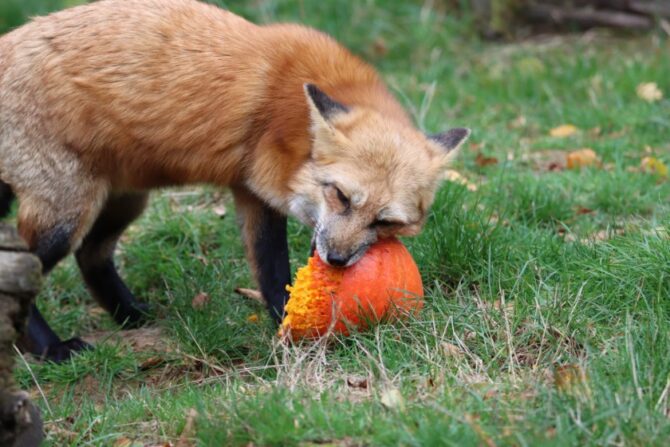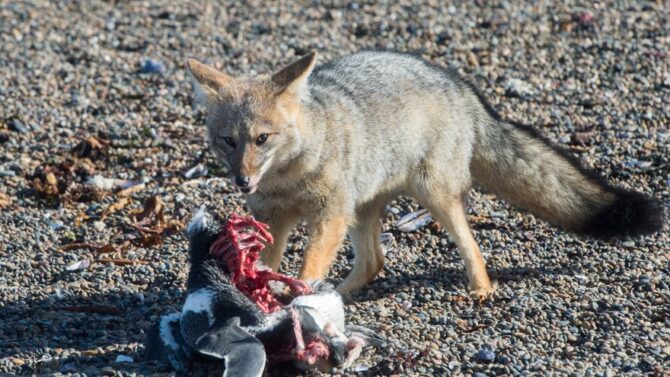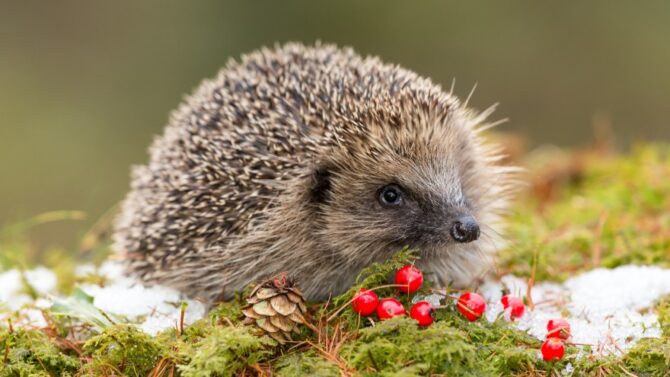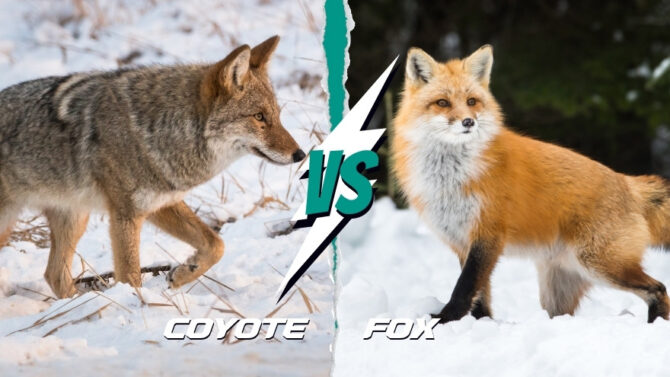The fox is a popular canid, alongside wolves and coyotes. It is also very widespread—especially the red fox—occurring in every continent except Antarctica.
These days, foxes and humans live side by side, and when it comes to their diet, one might wonder: “What do foxes eat?”
This is especially due to their reputation for stealing poultry. One also has to wonder if their dietary needs will push them to attack humans.
Though it seems otherwise, foxes are omnivores. They prioritize meat, but not at the complete exclusion of plant meals.
Attacks on humans are uncommon. However, we can’t say the same for your livestock!
Let’s explore the fox’s dietary habits and where they occupy the food chain.
Fox Diet: What Do Foxes Eat?
Foxes have an appetite for meat, right in tune with their canid relatives like wolves and coyotes. This is why those in urban settings are notorious for stealing poultry.
Their diet isn’t limited to chicken, however, as they can also hunt for rodents and other bird types.
Additional prey includes insects, reptiles, crabs, frogs, and even worms. Yes, their diet is wide.
That said, foxes aren’t carnivores. They are omnivorous creatures that feed on plants just as much as animals.

Plants are secondary options for these folks as they usually opt for those when they are out of meat sources.
Their preferred plant meal includes fruits, nuts, and dairy. They can also eat seeds and other forms of vegetation.
Foxes are not scavengers, but they aren’t selective, either. Given the opportunity, these creatures can feed on carrion.
If you have foxes in your environs, don’t be surprised to find one looking in your bin for leftovers!
How Do Foxes Get Food?
Foxes either hunt or forage for food, often at night, as it is nocturnal. It isn’t uncommon to find them during sunrise or sunset.
Some foxes even move around during the day when they have the opportunity.
The keyword for foxes is “opportunity,” and they hardly skip a good time to eat.
The foraging is done by looking for leftovers in the trash or plant material around their habitat.
Foxes are stealthy, possibly adding to their reputation as cunning in fairytales. It’s also why they successfully rob a farmer of his poultry without being caught.
Foxes prefer this stealth method over chasing down their prey, but again, opportunity trumps preference with these animals, and they chase when needed.
If they decide to chase, they do so with speed and agility. For example, the red fox moves at 30 mph while the gray fox goes 10 mph faster. That’s fast enough to grab a little animal.
Their hunting tools include teeth and all the senses. Foxes can hear up to 100 feet away, even if the prey happens to be a tiny rodent at that distance.
These ears can also move in different directions, giving them wide coverage.
Then we have the eyesight and nose, two additional hunting tools.
The eyes can see through the dark, and the nose can pick an animal underground. In comes the teeth that the fox uses to tear into flesh.
Foxes don’t always finish their meal at a go. Sometimes they store parts for later.
What Do Baby Foxes Eat?
Baby foxes are called cubs or kits. They depend on their mothers for food, much like human babies do.
Even more, they are born blind and have no chance of survival without their mother.
Their first meal is from the chewed-up meat their mother feeds them.
This continues till they can eat solid food, at which point the mother brings back small prey from her hunting expedition.
The prey she brings back are usually alive, so her baby foxes can practice killing them.

After some time, the babies accompany their mother to hunt. At this point, they’ve gotten enough killing practice which they apply in the fields.
What about pet baby foxes? Yes, having a pet fox is possible, and we’ll look into that next.
What Do Pet Foxes Eat?
Can a fox be a pet? Not like a domestic dog or cat. Though foxes can be friendly towards humans, they are inherently wild and require a lot of expertise to keep one in captivity.
Do not pet parent a fox if you have no experience in taming wildlife.
Moreover, not all fox species can be kept as exotic pets, despite their docile looks.
The only domesticated species is the Russian red fox, and even it can be a nightmare for some owners.1
Having said all that, a pet parent who decides to own a fox should be aware of its needs, especially in feeding.
The pet fox needs the nutrients that keep it going in the wild, namely, protein, vitamins, and minerals.
Dog food contains these nutrients and can be fed to a dog. Just ensure that it’s of high quality and comes without grains.
There are also feeds tailored for foxes, as well as raw meat and egg. Added to this are live prey like insects.
As omnivores, pet foxes will equally benefit from fruits like strawberries, blueberries, and apples.
Just don’t feed yours too much of it. Also, avoid potentially toxic fruits like avocado, grapes, and raisins.
Another plant product you can feed it is carrots.
Baby pet foxes can be fed with a puppy milk replacement. Solid food should come in only at 1 month, usually with an all-meat diet like rodents, chicken, and raw rabbits.
Only after some months should you bring in other forms of food.
What Do Wild Foxes Eat?
Wild foxes don’t need to depend on a human to feed, and this means they are responsible for getting their meal.
Though this leaves them open to eating something unhealthy, it also expands their range far more than the pet fox.
The wild fox diet is influenced by factors like climate and environment.
Foxes that find themselves in a cold area may feed on mammals that adapt to winter and fewer fruits.
When the weather becomes warmer, they have more options, including fruits.
The species with the widest dietary range is the red fox, as it occurs everywhere. It feeds on mice, squirrels, hamsters, and many other small mammals.
Is it Okay to Feed a Wild Fox?
With the increasing proximity between humans and foxes, you might find some in your area and be tempted to feed the “cute animal.”
However, it is not advisable. Wild foxes may not necessarily depend on you, but feeding it increases the chances of attacking.
Like other wild canids, foxes are wary of humans and tend to stay on their own.
Though friendly, a true wild fox will keep its distance. Feeding it makes it courageous, which may not be safe in the long run.
Do Foxes Have Enemies?
Young foxes are the most vulnerable to attacks from predators like eagles and their fellow canid, the coyote.
Foxes are generally small, and the young fox even more so. This puts it in a vulnerable position.
The mature fox has fewer enemies, but it isn’t at the top of the food chain in its habitat.
It faces predation from animals like bears, mountain lions, wolves, and even eagles.

The biggest threat foxes face is hunters. Fox hunting has been around for years, though it is now highly regulated in the United States.2
Foxes might also be killed as a form of self-defense from farmers.
The next conflict comes when foxes attack humans, and though this is rare, it can happen if the fox is rabid or handled.3
Dive Deeper: Coyote vs. Wolf vs. Fox: Discover the Differences
List of Fox Food
Foxes are omnivorous, meaning that they eat both meat and plants. Their diet varies depending on the species and the environment in which they live.
Below is a list of common food sources for foxes:
- Poultry
- Other birds
- Rodents
- Rabbits
- Frogs
- Insects
- Worms
- Reptiles
- Crabs
- Molluscs
- Carrion
- Raccoons
- Fruits
- Vegetables
- Fungi
- Eggs
Related Questions
What is a fox’s favorite food?
Though they are omnivores, foxes eat more meat due to the protein that they need. Examples of animals they feed on include birds, rodents, and insects. If it is a domesticated fox, be sure to include meat in its daily diet.
What do wild red foxes eat?
Wild red foxes are widespread all over the world, and their diet reflects this. It ranges from rodents like squirrels to fruits. As opportunistic animals, they go after what they have.
What is poisonous to foxes?
There are certain fruits and products you should never feed a fox, wild it domestic. This includes avocado and chocolates.
Summary
Foxes may be thieves, but they are not as harmful as some might think.
These creatures are omnivores and do not have the same bloodlust aggressiveness other canids tend to have.
References & Notes
- Russian domesticated foxes. JAB Canid Education and Conservation Center.
- Fox hunting regulations. Mass.gov.
- What to do about foxes. The Humane Society of the United States.






